Nelson's Castle
Nelson Museum A historical documentation of English life
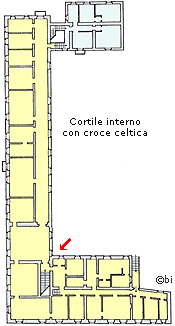 The Ducea noble wing that now has become a museum, was once the residence of Horatio Nelson heirs (the Castle). The Ducea noble wing that now has become a museum, was once the residence of Horatio Nelson heirs (the Castle). It is probable that it represents the most consistent disposition of volumes of the old Benedictine monastery. Certainly is the one which arrived to us in the best condition as, once passed to the Nelson, was restructured and used as permanent residence. Many rooms and structures that constitute the building complex were built during the first half of the XIX° century. At that time, what remained of the ancient Benedictine abbey was healed and incorporated into a new building. Were restructured above all the rooms that went from the right of the church portal going around the cloister. The noble wing, placed to first floor, looks on the botanical garden and the principal court yard of the complex, at the center of which, to honor Horatio Nelson, there is the large Celtic cross wanted by Lord Alexander Nelson-Bridport at the end of XIX° century. A long corridor gives access to all the rooms looking west on the English garden, on which can be seen the biggest part of furnishing left by the heirs of the Nelson family.
|
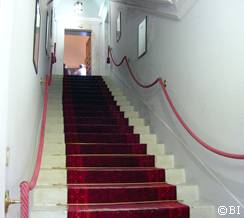 | 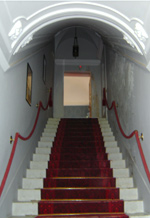 | 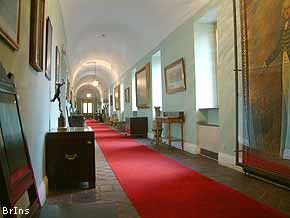 | 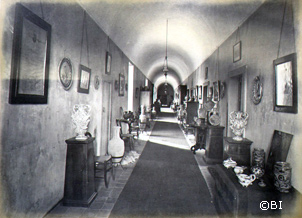 | | The stairs leading to the Nelson stately apartments and the long corridor leading to the many rooms, now a museum. The black and white photo of the corridor dates back to 1880, at the time of the 4th Duke of Bronte, Alexander Nelson Hood, Viscount Bridport (1814 - 1904). |
|
| |
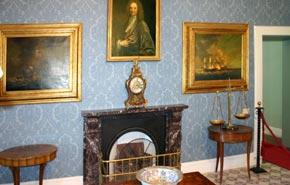 «The long corridor, 150 feet long - wrote the 5th Duke Alexander Nelson Hood (The Duchy of Bronte) in 1924, has, on the walls, paintings and prints almost exclusively by Nelson and the Hoods. They came from Cricket, after its sale, or from Royal Lodge, after the death of my father (the rest of the paintings and prints of the family battles, are in Falconara, Taormina, or in London at no. 13 Pelham Crescent)». «The long corridor, 150 feet long - wrote the 5th Duke Alexander Nelson Hood (The Duchy of Bronte) in 1924, has, on the walls, paintings and prints almost exclusively by Nelson and the Hoods. They came from Cricket, after its sale, or from Royal Lodge, after the death of my father (the rest of the paintings and prints of the family battles, are in Falconara, Taormina, or in London at no. 13 Pelham Crescent)». In the corridor are displayed paintings and prints depicting the English admiral and his descendants, autographed letters of the English royals, medals and naval battle plans, military orders, sarcophagi, Roman amphorae and archaeological finds found during the recent excavations carried out for the renovation of the Duchy. In the two photos on the right, the large room that leads into the long corridor and a painting depicting the Battle of Trafalgar. «In room no. 2 - writes the 5th Duke, Alexander Nelson Hood, in his "Memorie scritte per la famiglia" (Memoirs written for the family) - there are portraits of our Royal Family, given to my father by Queen Victoria on different occasions. (...)
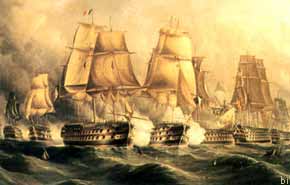 Of the five busts, three of plaster, one of marble and one of bronze, numbers 1, 2 and 3 on the left starting from the Hall are: the first of Admiral Viscount Hood; the second of Maria Marchioness of Downshire, my mother's mother; the third of Elliot, Lord Heathfield, Conqueror of Gibraltar. Of the five busts, three of plaster, one of marble and one of bronze, numbers 1, 2 and 3 on the left starting from the Hall are: the first of Admiral Viscount Hood; the second of Maria Marchioness of Downshire, my mother's mother; the third of Elliot, Lord Heathfield, Conqueror of Gibraltar.
This last bust was given to my father, at Windsor Castle, by Queen Victoria who, being informed that it was a bust of Admiral Lord Hood, said that she thought my father would like to have it. On its arrival at Cricket the coat of arms on the pedestal confused me because it did not look like that of Lord Hood.» Attraverso la Ducea Nelson in La Ducea di Bronte (Through the Nelson Duchy in The Duchy of Bronte) by A. Nelson Hood, Bronte, 2005)
And William Sharp who was "a guest at the welcoming Castle of Maniace" three times wrote in ecstasy that «from my rooms I can go into the great central corridor (a museum of beautiful and interesting objects, with delightful vases, ancient Greek sculptures, rare Greek-Sicilian moulds and a veritable museum of Nelson articles of every kind, engravings and coloured prints and other such objects connected with the great admiral) and from the balcony at the north end, overlooking the rapid grey-green waves (sometimes a thin and swift stream and sometimes a furious torrent) I look over the castle walls to the lonely hill pastures...»
«Or I can go to the other end of the corridor and through the drawing room and music room into the dark oak-panelled breakfast room and looking out of one of its windows admire Mount Etna which towers very close: and relive scenes such as those depicted in Empedocles on Etna." | | 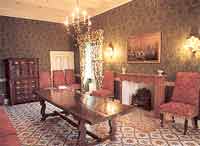 | 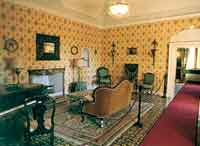 | 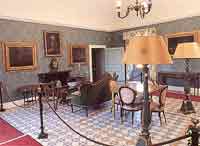 | 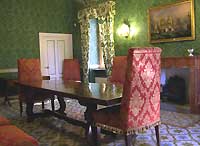 | 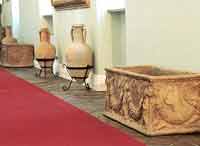 | 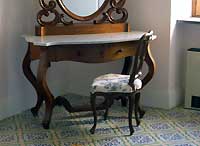 The Museum is historically interesting but also full of extraordinary charm and beauty. On the left of the long corridor are the sumptuous apartments of the English Dukes still adorned with the original furnishings (the bedrooms, the study, the dining room, the bathrooms, the bathrooms etc.) and partly tiled with original 18th century majolica floors. The Museum is historically interesting but also full of extraordinary charm and beauty. On the left of the long corridor are the sumptuous apartments of the English Dukes still adorned with the original furnishings (the bedrooms, the study, the dining room, the bathrooms, the bathrooms etc.) and partly tiled with original 18th century majolica floors.
The rooms themselves have also been scrupulously restored. Replicas of the original floor tiles have been made for each room and a section of the old tiles has been left, protected, in place as a comparison. In addition to the rooms, bathrooms and kitchens, rigorously furnished with furniture and furnishings of the period, numerous other art objects are preserved in the Castle. 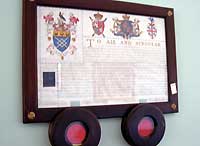 The rooms preserve precious relics, everyday objects and numerous works of art that belonged to the Nelsons: portraits of Lady Hamilton or Queen Victoria with Prince Consort Albert, autographed letters from the royals of England, highly valuable furnishings and furniture of various styles, 19th-century vases and clocks, finely crafted chests, 18th-century Calatina majolica, prints and paintings by English artists (Luny, Paton, Spencer, Elliot), Neapolitan porcelain and the Nelson coats of arms. The rooms preserve precious relics, everyday objects and numerous works of art that belonged to the Nelsons: portraits of Lady Hamilton or Queen Victoria with Prince Consort Albert, autographed letters from the royals of England, highly valuable furnishings and furniture of various styles, 19th-century vases and clocks, finely crafted chests, 18th-century Calatina majolica, prints and paintings by English artists (Luny, Paton, Spencer, Elliot), Neapolitan porcelain and the Nelson coats of arms.
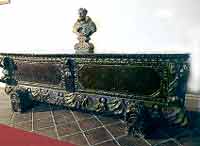 In the Nelsons' rooms, the butlers or the numerous servants are no longer visible, the kitchens, stoves and fireplaces are off and everything is still, but in a great silence, the history and magic of the place, which has remained unchanged, emerge to mind, as do the suffering of the poor people of Bronte, oppressed and dispossessed for centuries of their wealth in favor of the historic large and new hospital of Palermo first and of Nelson and his descendants later. In the Nelsons' rooms, the butlers or the numerous servants are no longer visible, the kitchens, stoves and fireplaces are off and everything is still, but in a great silence, the history and magic of the place, which has remained unchanged, emerge to mind, as do the suffering of the poor people of Bronte, oppressed and dispossessed for centuries of their wealth in favor of the historic large and new hospital of Palermo first and of Nelson and his descendants later.
The furniture is a mixture of styles: some of it was brought from England, some, such as the 6th century refectory table, is believed to be part of the original friary furniture. Other pieces were bought locally by the Bridports and include some magnificent examples of Sicilian craftsmanship. The house is in many ways a monument to Horatio Nelson, with reminders of his life and victories throughout.
| | Some of the many objects on display in the corridor and in the various rooms of the museum. The two busts on the right are of the 5th Duke (Alexander Nelson-Hood, 1854-1937) and of a very young Alexander Nelson-Hood (VII, now Duke of Bronte). The clock in the centre in brass and tortoiseshell is from the 19th century. | | 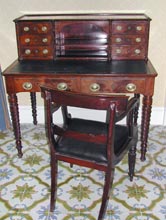 Among the period furniture, everyday objects and memorabilia of various kinds, present in the rooms of the Museum, are exhibited medals and diplomas with original seals awarded to the Bridports, military orders, battle plans, the terminal mast of the yardarm and the bell of Nelson's ship and the two crystal glasses and the bottle with which, before dying, the Admiral and his officers toasted the victory the night before the battle of Trafalgar (21 October 1805); the crystal service was placed (and still is) in a niche to keep it still in the roughest seas. Among the period furniture, everyday objects and memorabilia of various kinds, present in the rooms of the Museum, are exhibited medals and diplomas with original seals awarded to the Bridports, military orders, battle plans, the terminal mast of the yardarm and the bell of Nelson's ship and the two crystal glasses and the bottle with which, before dying, the Admiral and his officers toasted the victory the night before the battle of Trafalgar (21 October 1805); the crystal service was placed (and still is) in a niche to keep it still in the roughest seas.
Unfortunately the Museum, just three years after the purchase by Bronte's Council, suffered in 1984 a very grave robbery of about twenty precious works (between paintings and furniture) that yet have not been recovered. 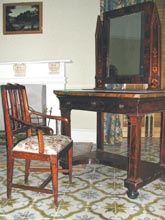 Salvo Nibali, impassioned scholar and researcher of Sicilian monasticism, in his book "Il Castello Nelson" (The Nelson Castle) (1985) reports a list of the things stolen: Salvo Nibali, impassioned scholar and researcher of Sicilian monasticism, in his book "Il Castello Nelson" (The Nelson Castle) (1985) reports a list of the things stolen:
- J. Wyck: Soldiers in a wheat field;
- Meadows: Wood landscape with farmers and animals; - disciple of J. M.W. Turner: Figures on a sidewalk; - disciple of G. Dughet: Figures in a wood landscape; - Monomy: Ships, battles and barges in rough sea; - Lietenant William Elliott: Victory with admiral Hood near Bastia. - Thomas Luny: Action during the battle of the saints and the Capture of the city of Paris. - Coloured glass engraving depicting the death of Nelson. Together with these pictures were also stolen furnishings and furniture of great value and styles; a walnut table of style XVII° century, four walnut bedside tables, a mirror, and three walnut chests of drawers of the XVIII° century. | |
|
|